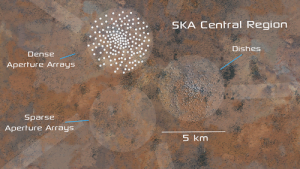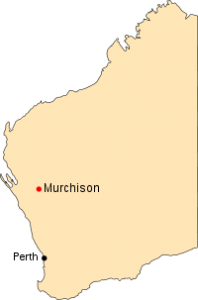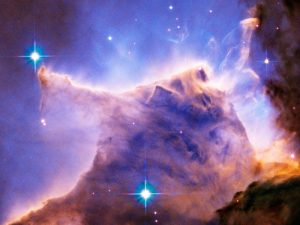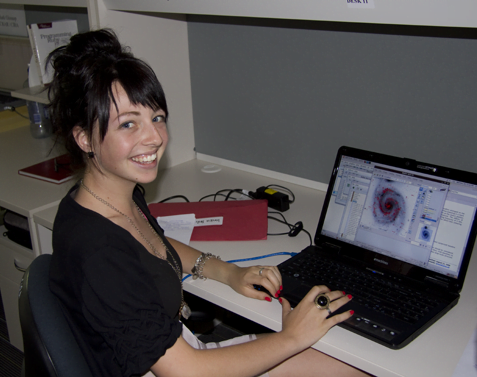November 23rd, 2010

Artist’s impression of the central region of the SKA. Click image for bigger. Credit: Swinburne Astronomy Productions and the SPDO.
Many hours of researching, e-mailing and writing applications has led me, Innika, to be sitting at a desk (complete with a brand new Apple Mac) ready to tackle one week of amazing and exciting tasks at ICRAR. I’ve always aspired to lead a life filled with everything astronomical and astrophysical and this seemed like the perfect place to start.
A tour of the building and an introduction to some of the most important people involved with ICRAR has left me incredibly excited for the week ahead. Kirsten Gottschalk, Education and Outreach officer and my ‘Mum’ for the week was brilliant and made me feel right at home, the desk area she set up for me had sticky notes everywhere, a folder and even a brand new notebook. Talking to her revealed that she studied the same course that I plan to study at the same university and she also attended the National Youth Science Forum, which I am also attending in January.
Wasting no time, Kirsten introduced me to Dr Martin Meyer, one of the Research Associate Professors at ICRAR. He introduced me to some of the projects he is working on and showed me a program that can be used to detect galaxies amongst space ‘noise’ by looking at the frequencies they emit. He is currently designing a better and more accurate program for use with the SKA and to use something similar to this is a remarkable opportunity.
The afternoon saw me attend a talk to Western Power with Kevin Vinsen where he talked about how Western Power can be involved in the power needed for the Square Kilometre Array (SKA) and the technological and power developments that need to happen for it to take place.
I can’t wait for the next couple of days, thank you for reading this and I will keep you posted on what happens!
November 24th, 2010
 Today, Kirsten and I worked at the Curtin University ICRAR office. After getting lost on the campus (which is incredibly large), I had a tour around the office and I was introduced to most of the people that work in the office, including Jean-Pierre or ‘JP’ as he is affectionately known, who assured me that he could, if I ever got bored, give me some math problems to solve. To my surprise, the office was almost deserted at 930. Kirsten informed me that some researchers work flexibly, they tend to arrive late in the morning but stay later at night.
Today, Kirsten and I worked at the Curtin University ICRAR office. After getting lost on the campus (which is incredibly large), I had a tour around the office and I was introduced to most of the people that work in the office, including Jean-Pierre or ‘JP’ as he is affectionately known, who assured me that he could, if I ever got bored, give me some math problems to solve. To my surprise, the office was almost deserted at 930. Kirsten informed me that some researchers work flexibly, they tend to arrive late in the morning but stay later at night.
My morning session with Dr Megan Argo, another research astronomer at ICRAR consisted of using a program to analyze real data of our nearest neighbor, the Andromeda Galaxy. There were over 1000 different objects in the galaxy including novae, supernovae and stars. She gave me a copy of the report she has just written which involves the research she has done with this program, it was fantastic to be able to read the report and know exactly what she was talking about.
I was also fortunate enough to meet David Emrich, who is a commissioning engineer helping to build and manage the radio telescopes at Murchison, the potential site of the SKA. He took me through some of the technological aspects of building the telescopes and told me about how he manages the field trips he conducts at Murchison. We managed to find ourselves with free time, which we filled chatting about physics, jobs, university and life in general – it was fantastic to be able to hear all about someone else’s life experiences.
November 25th, 2010
Back at UWA today (phew – no way I could get lost!) and it was a very pleasant day. A school group visited ICRAR, so I sat in on the talk that Kirsten gave and helped Pete Wheeler (Education and Outreach Manager) in demonstrating how some of the telescopes work. The school kids were all very enthusiastic and even knew more about the solar system than some of their teachers.
In the afternoon I had a session with Dr Alan Duffy whom is a research astronomer working on all different types of research simulations. He was extremely knowledgeable and great fun to be around and learn from, it was a very fun session. After this we all attended a seminar, which is a regular occurrence here at ICRAR. This week it was Dr Katie Mack, who spoke about 21cm forests in relation to radio astronomy. Drinks and nibbles were provided after the seminar, which was a lovely way to end the day.
November 26th, 2010

The Eagle Nebula. Click image for bigger. Credit: NASA, ESA, and The Hubble Heritage Team (STScI/AURA)
It’s my last day and I can honestly say I really don’t want it to end! Dress today was rather formal – ‘JP’ described it as his Sunday Best (on a Friday) – as we had VIP’s at lunch. The entire board for ICRAR was there, it was brilliant opportunity to meet and talk to some very important and influential people.
In the morning I got to have a research session with Dr Aidan Hotan, a research astronomer and the course co-coordinator at Curtin. I was fortunate enough to meet one of his honors’ students, Tim, who was very enthusiastic and knowledgable. I was educated about Pulsars, the topic of Tim’s thesis, and was lucky enough to analyse some of the data that both of them collected during a trip to Tasmania.
After lunch (which was delicious) I met Dr Randall Wayth who is another research astronomer at ICRAR. We discussed all different types of radio waves and looked at the differences between analog and digital frequencies, as well as looking at a frequency plot of the FM stations on a computer.
My week here is over and I can honestly say that I don’t want to go. ICRAR have taken me under their wing and made me feel so special, my quote to my Mum when I got home after just my first day was “if I could do what I did today for the rest of my life, I would be the happiest person alive.” For anyone interested in a career in astronomy or astrophysics, I wholeheartedly recommend applying for work experience at ICRAR. It was one of the most enjoyable and fulfilling weeks I have had in a long time.
My thanks go to Ms Kirsten Gottschalk who is one of the most outgoing and excitable people I have met and was incredibly easy to get along with. On Wednesday I had to confess to her that I left my lunch in the fridge at home, to which she replied with a giggle and said ‘Me too!’ She was instrumental in making the week such a success. My thanks also go to Professor Peter Quinn, the director of ICRAR, for willingly taking me on, as well as each and every researcher that spent time working with me, they were incredibly inspiring, enthusiastic and knowledgeable and I am so appreciative of all the time they gave up.
Innika DeRosa
